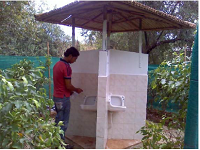/topics/sanitation-and-hygiene
Sanitation and Hygiene
Influence of anthropogenic contamination on fluoride concentration in groundwater: A study of Mulbagal town Kolar district Karnataka
Posted on 22 Nov, 2014 10:30 AMGroundwater contamination is a serious, but relatively ignored issue in the country. This contamination occurs in either through geogenic or anthropogenic means. Fluoride contamination is one such example of geogenic contamination that is widely found in the Kolar district of Karnataka. However, the fluoride levels in the town of Mulbagal are lower than those in the surroundings. Earlier, a study was conducted on the impact of pit toilets on the groundwater in the area. The present paper investigates the presence of any link between these two phenomena.
Guidelines on the integrated low cost sanitation scheme by Ministry of Housing and Urban Poverty Alleviation 2012
Posted on 22 Nov, 2014 10:30 AMThis document by Ministry of Housing and Urban Poverty Alleviation provides guidelines for the low cost sanitation scheme. The main objective of the scheme is to convert the existing dry latrines into low cost flush latrines and to construct new ones.
Analysis of Delhi's budgetary allocations for water and sanitation services in slum areas Article in Economic and Political Weekly
Posted on 22 Nov, 2014 10:30 AMThis article in Economic and Political Weekly, by analysing various budget documents, attempts to capture the quantum of budgetary outlay for Water and Sanitation Services (WSS) in the slums of Bawana and Bhalaswa in Delhi. Further it captures various systemic weaknesses that impede the effective delivery of WSS in these two slum areas.
A communication and advocacy strategy framework for sanitation and hygiene by the Ministry of Drinking Water and Sanitation and UNICEF 2012-17
Posted on 22 Nov, 2014 10:30 AMThe number people practicing open defecation in India is more than 600 million. Though the access to improved sanitation has increased since 2000 the pace of change has been slow. If the current trend continues then it will be difficult for the country to meet its Millenium Development Goal for sanitation. Thus accelerating access to and use of toilets and hygiene practices have become a national priority.
A toilet that loves the environment: A film by the Himalaya Seva Sangh highlighting Uttarakhands experience with ecosan toilets
Posted on 22 Nov, 2014 10:30 AMThe Himalayas are inhabited by 40 million people, most of whom are dependent on agriculture and animal husbandry. The prevalent water scarcity also means a lack of water for sanitation. In this case, both open defecation and conventional sewerage pose a health risk. Conventional toilets not only consume a lot of water, but the effluent also pollutes groundwater.

A resource book on waterless urinals: an ecological sanitation method that saves water energy and uses urine as a resource
Posted on 22 Nov, 2014 10:30 AM
Waterless urinals (WLU) save water, energy and use urine as resource ( Image courtesy: R Sakthivel)
Towards self reliance and access to safe drinking water and secure sanitation in north Bihar : A report by Megh Pyne Abhiyan
Posted on 22 Nov, 2014 10:30 AM
Wastewater irrigation in Hubli-Dharwad Karnataka enables farmers to diversify their cropping practices: A paper in the Environment and Urbanisation Journal
Posted on 22 Nov, 2014 10:30 AMThis paper 'Wastewater irrigation in Hubli–Dharwad, India: I
Compendium of sewage treatment technologies by Indian Institute of Technology Kanpur
Posted on 22 Nov, 2014 10:30 AMThis compendium of sewage treatment technologies by the Indian Institute of Technology (IIT), Kanpur has been prepared, based on primary and secondary data gathered from operation of sewage treatment plants (STPs) in the country over the last two decades.
Water Towards a paradigm shift in the Twelfth Plan A paper by Mihir Shah in the EPW
Posted on 22 Nov, 2014 10:30 AMA fundamental change in the principles, approach and strategies of water management in India has been proposed in the Twelfth Plan
Why is this paradigm shift needed ?





